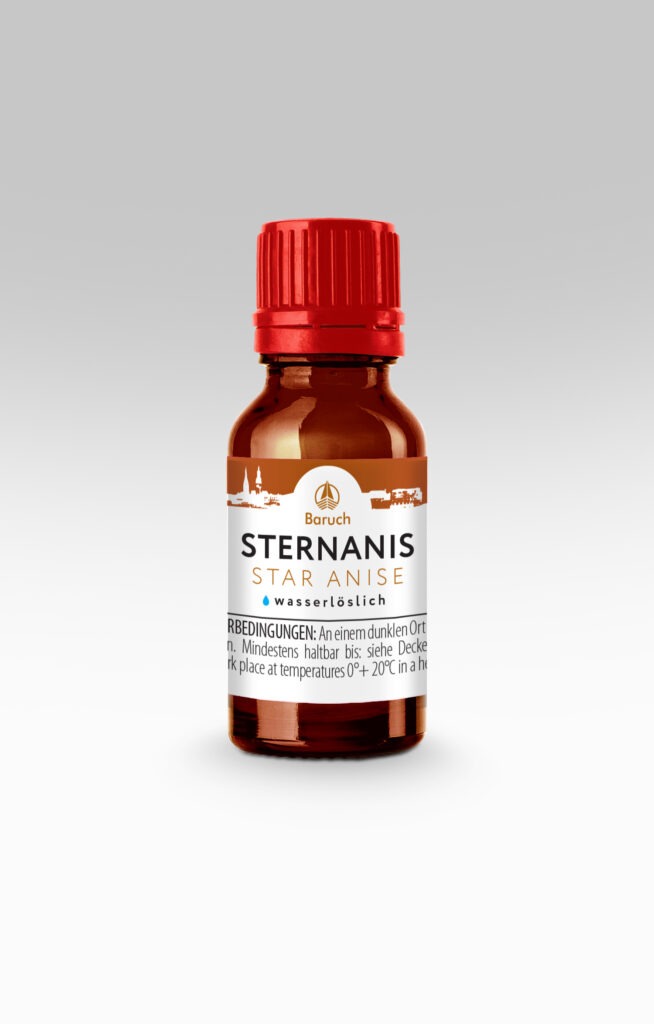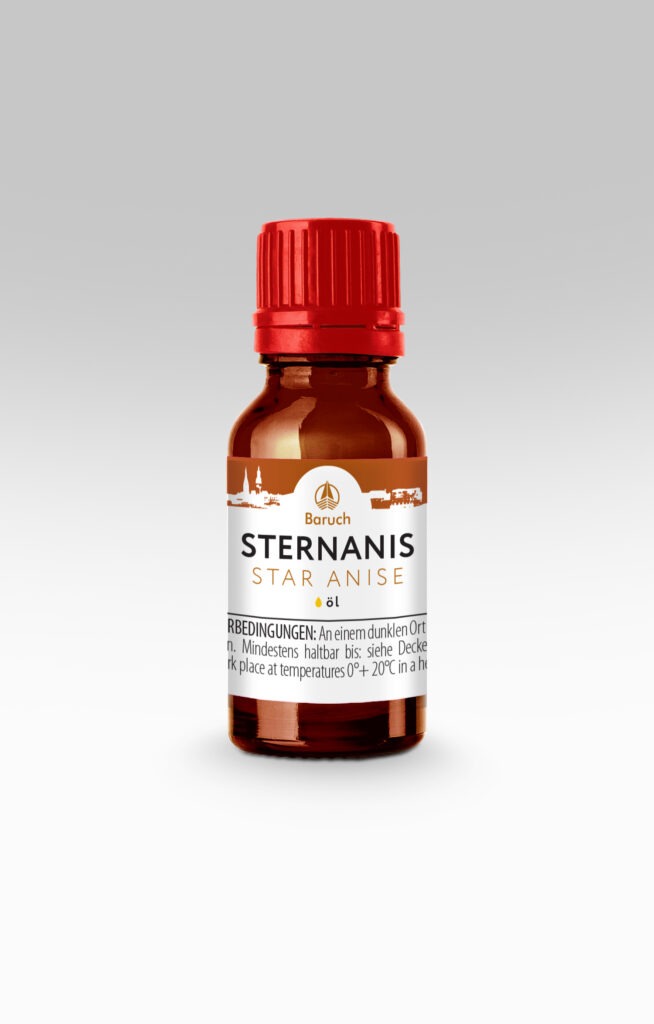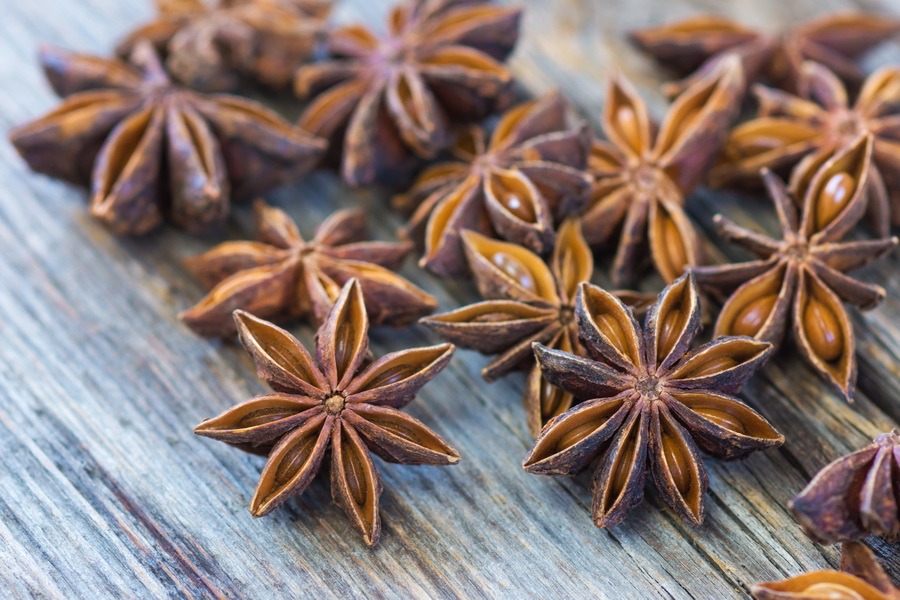Illicium verum, also known as star anise, Chinese anise, Indian anise, badian and even Siberian anise. The last surname is generally surprising since star anise does not survive in Siberia. In China, Korea and Japan there is a very similar fruit plant – Illicium anisatum or Japanese star anise, the sale and use of which is prohibited due to its high toxicity.
CO2 extract from star anise has a diuretic and antispasmodic effect, relieves bronchial cramps and asthma attacks, fights flatulence, relieves constipation, relieves abdominal pain, improves intestinal motility and appetite. Promotes the liquefaction and removal of mucus from the lungs, is used to treat colds and circulatory diseases, cures hoarseness. Strengthens the heart in tachycardia, stimulates the kidneys and liver, the production of estrogen (in women). It has a mild calming effect on stress and depressive states and helps against over-excitability in children.
CO2 extract from star anise, as well as essential oil from star anise, is traditionally used in food production in China and other countries in the Southeast. In Europe, star anise extract and oil are particularly widely used in the manufacture of baked goods. The aroma and taste of star anise goes well with meat and is used in the manufacture of canned fish. Ideal for preparing food and fruit preserves as well as for preparing various sauces. The taste and aromatic properties of the СО2 extract from star anise are not lost during the heat treatment. Star anise is often used in the production of alcoholic beverages such as the Greek aniseed vodka “Ozo”. In terms of taste, the star anise CO2 extract is perfectly combined with similar extracts from black pepper, fennel, cinnamon, cloves and ginger. This mixture is a classic combination of spices.
CO2 extract from star anise “Biozevtika” is an oily liquid of yellow color with a pleasant, distinctive aniseed smell and sweetish taste.


Chart 1. The main components of the CO2 extract of star anise
| NAME | CONTENT IN% OF THE AMOUNT OF VOLATILE COMPONENTS | EFFECT |
|---|---|---|
| Anetol | 50 | Stimulates the work of the stomach, digestive, milk-forming, expectorant, insecticidal. |
| Limonen | 3 | Perfume, antifungal and aseptic. |
| Myrcene | 3 | Used as a fragrance in perfumery. |
| Alpha and Beta Philandre | 1,8 | Used in medicine as a warming agent and in perfumery as a fragrance. |
| Bergamots | 1,4 | Improves blood circulation, dilates blood vessels, normalizes cholesterol, bactericidal, strengthens immunity and the digestive tract. |
| Alpha- and beta-pinene | 1,1 | Locally irritating, expectorant, antiseptic, diuretic. |
| 1,8-cineole | 0,9 | Extremely strong antiseptic, heals, relieves pain. |
| Palmitic acid | 3 | Unsaturated fatty acid for water repellency in cosmetics. |
| α- and β-linolenic acid | 0,2 | Unsaturated, essential fatty acids from the class of omega-3 fatty acids. It has a membrane protecting, angioprotective effect. Immunomodulatory, improves brain metabolism. |
| Linoleic Acid | 30 | An essential unsaturated fatty acid of the omega-6 class. It has anti-inflammatory, vasoconstrictor, and aggregating effects. If there is no balance between omega-3 and omega-6 fatty acids, competitive processes can arise that influence the metabolism. |
In the manufacture of cosmetic products, star anise oil is mainly used in the countries of Southeast Asia. This oil and CO2 extract has the following cosmetic properties:
- increases the turgor of aging skin
- gives the skin elasticity
- normalizes the skin’s water-fat balance
- has an antiseptic effect
- Currently, wild star anise is extremely rare in mountainous, tropical forests in southern China and Vietnam. Cultivated in Southeast Asia and Central America.
Chart 2. Application rates, recommendations for the use and storage of the CO2 extract from star anise
| Food usage rates | Item А100: 0.001% (10g per ton) Water-soluble microemulsions EMA1: 0.1% (1l per 1000l or 1ml per liter) |
| Application rates in cosmetics | Item А10: 1-3% Item А100: 0.1-0.3% Item EMA1: 10-30% Item EMA5: 2-6% |
| Recommendations for use | It is recommended to add CO2 extracts in the final stages of preparation, in the cooling phase of the end product. |
| Storage Instructions | Storage advice |
| Use in dietary supplements | Application in cooking | Application in cosmetics |
| It has a diuretic and antispasmodic effect, relieves bronchospasm and asthma attacks, fights flatulence, eliminates constipation, relieves stomach pain, improves intestinal motility, improves appetite. Promotes the liquefaction and removal of sputum from the lungs, is used for colds and circulatory diseases, for hoarseness. It supports the work of the heart during tachycardia, stimulates the work of the kidneys and liver, the production of estrogen (in women). It has a mild sedative effect in stressful and depressive states, helps with colic and hyperexcitability. | The oil is used in food production in China and Southeastern countries. Star anise extract and oil are used extensively in Europe to make pastries and baked goods. The aroma and taste of star anise goes well with meat, it is also used to make canned fish. Ideal for preparing dishes and preserves from fruits and preparing various sauces. The taste and aromatic properties of the CO2 star anise extract are not lost during heat treatment. Star anise is commonly used in the production of alcoholic beverages such as the Greek aniseed vodka ouzo. In terms of taste and aroma properties, CO2 star anise extract is perfectly combined with similar extracts of black pepper, fennel, cinnamon, clove and ginger. This blend is a classic spice combination. | The oil is widely used in cosmetic products in Southeast Asia. CO2 extract has the following cosmetic properties: – increases the turgor (water binding capacity of the collagen fibers of the dermis) of mature skin; – gives elasticity to the skin; – normalizes the water-fat balance of the skin; – has an antiseptic effect. |
